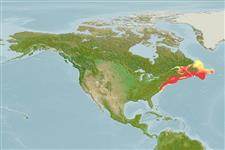Common names from other countries
Environment: milieu / climate zone / depth range / distribution range
Ecologia
; intervalo de profundidade 0 - 480 m (Ref. 4), usually 4 - 50 m (Ref. 4). Temperate, preferred 6°C (Ref. 107945); 54°N - 35°N, 78°W - 52°W (Ref. 4)
Northwest Atlantic and Western Atlantic.
Length at first maturity / Tamanho / Peso / Idade
Maturity: Lm 8.8, range 7 - 9 cm Max length : 114 cm TL macho/indeterminado; (Ref. 81053); common length : 25.0 cm TL macho/indeterminado; (Ref. 4); Peso máx. publicado: 1.7 kg (Ref. 81053)
Benthic in coastal and shelf waters (Ref. 106894). Possibly a selective feeder, preying mainly on crabs, echinoderms, mussels and polychaetes but also ingesting algae and seaweeds, with a complex foraging behavior and thus capable of maintaining gross diet composition despite of sharp variations in prey availability, seasonality and ontogenetic changes, e.g., molt- and size-related diet shifts (Ref. 33024). Migration does not occur, or only to a limited scale (Ref. 4).
Life cycle and mating behavior
Maturidade | Reprodução | Desova | Ovos | Fecundidade | Larvas
The females carry their eggs for 10 to 11 months, ovigerous females are found throughout the year (Ref. 4). 0.5 broods per year (Ref. 81148); 0.15 cm postlarval size (Ref. 81158); 1 month pelagic period (Ref. 81159).
Holthuis, L.B. 1991. (Ref. 4)
Status na Lista Vermelha da IUCN (Ref. 130435)
Status no CITES (Ref. 108899)
Not Evaluated
Not Evaluated
Uso pelos humanos
Pescarias: altamente comercial
FAO - pescarias: landings, perfil da espécie | FishSource | Sea Around Us
Ferramentas
Fontes da internet
Estimates based on models
Preferred temperature
(Ref.
115969): 2.7 - 15.4, mean 10.2 (based on 112 cells).
Resiliência
Baixo, tempo mínimo de duplicação da população 4,5 - 14 anos (K=0.07-0.09; tm=5).
Prior r = 0.47, 95% CL = 0.31 - 0.71, Based on 2 full stock assessments.
Vulnerabilidade
Moderate to high vulnerability (46 of 100).
